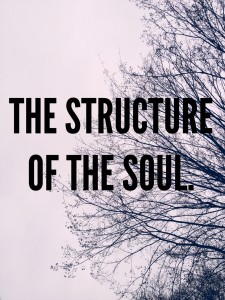The Spirit of Automation (Part 5)
By Asher Crispe: May 3, 2013: Category Inspirations, Living with the Times
There are many ways in which we can map a personality, image a psyche and structure a soul for the purpose of analysis. We can look at a high res scan and get a glimpse of the fine detail or we can settle for more of a course-grained approach which will grant us a sense of the basic features, key elements and general lines of force. If we opt for the latter, then we may come to find in the Hebrew the expression for the anatomy or structure of the soul– “mivneh ha’nefesh” [מבנה הנפש]–the picture in broad brush strokes. The word “mivneh” relates to the word “boneh” (to build) and “binah” (to conceptually understand). As such, any conceptual understanding of the soul entails some degree of constructivism. The dynamics of the soul and the genesis of our inner experience are built out of fundamental elements which lead to the emergence of more complex patterns and subtle textures of our sense of self.
Looking closely at the word “mivneh” (structure) we see that it is composed of four Hebrew letters: Mem-Beit-Nun-Hei. Accordingly, two of the letters Beit-Nun form the inside of the word which spells Ban [ב”ן] while the two outside letters (the book ends) are Mem-Hei which spell Mah [מ”ה]. As we have mentioned earlier in our series, Mah and Ban correspond to the Sabbath and the weekday periods of time as well as to the human (the one who questions) and the animal (the unquestioning state of conforming to one’s nature). We might add to this list and point out that the relationship of Mah to Ban in Kabbalah can also be rendered as the relationship of the heavens to the earth.
Graphically, we often depict this as the ground or earth as the solid center which is surrounded by a relatively intangible atmosphere. Consequently, this new information can aid in our explanation for why the animality of the soul is placed hyper-literally at the center of the word (in the mindset of the kabbalist this is a decidedly non-random feature of the word which is fair game for bringing our interpretive focus to bear upon it). All this suggests that the position of centrality within our consciousness is that of our natural animality (the prevalence of the mundane which anchors our sense of self and grounds our psyche). The solidity of the animal-earth provides a base which is wrapped in the envelope of the human-heavens.
Here the human continually seeks to blast off, to transcend the animal-earth and the limited natural conditions of existence. Metaphorically the heavens denote an abstraction which could be taken to signify transcendence while the concrete earth marks the domain of immanence. With the human (Mah) straddling the animal (Ban), the animal is directed and uplifted. Reframed in terms of the transcendent/immanent pairing, this would imply that the transcendent ‘rides’ upon the immanent. So too, the Sabbath ‘rides’ upon the weekdays. Rest ‘rides’ upon work. With the consideration of the interinclusion of these two aspects, we could formulate the weekday within the Sabbath as the immanent within the transcendent and, at the same time, the Sabbath within the weekday would amount to the the transcendent within the immanent. Earth ascends to heaven (dematerialization) and heaven descends to earth (an ‘immanent transcendence’ or the materialization of the ‘beyond’ in the ‘below’). The mundane becomes Holy and the natural turns miraculous while the supernatural simultaneously turns into the natural. We go out and beyond by going within.
With the soul being structured in terms of the union of Mah and Ban (which we said before equal 45 and 52 respectively and which collectively add up to 97 which is the equivalent of the word zeman or ‘time’), we will move on to examine how these features are built up layer upon latter with another mathematical allusion. In Kabbalah, there is a concept known as mispar kidmi (literally the preceding numbers or the numbers in front of a given number as if one were counting up to that number using gematria) which is taking the triangular value of a word. Let’s cite a simple example: if we take the letter Hei in Hebrew it has a numerical value of 5 but in order to reach 5 we had to pass through 1,2,3,4 first (which are represented by the letters Alef, Beit, Gimel and Dalet). Thus the triangular value of Hei would be the sum of all the letters from Alef to Hei or the numbers from 1 to 5 which equals 15. The trick is when we count letters after Yud (10) such as Kaf, Lamed, Mem…. They don’t continue the series as 11, 12 and 13 but rather are counted as 20, 30, and 40. With all of this in mind we might ask why this process is relevant? The response is that it demonstrates the hishtalshelut form (evolutionary development) of a given term or number.
Granting all of these mathematical manipulations, what is the ultimate evolution of our terms Mah and Ban? Or, to put it differently, what is the end result of marrying the process of becoming-human (represented by layers of the triangle or pyramid) with the process of becoming-animal? What does the progressive build up of transcendence and immanence look like when it is complete?
The response lies buried in the mispar kidmi or triangular value of the words Mah and Ban. Mah is written Mem-Hei so all of the letters up until Mem are Alef, Beit, Gimel, Dalet, Hei, Vav, Zayin, Chet, Tet, Yud, Kaf, Lamed, Mem which represent the numbers 1,2,3,4,5,6,7,8,9,10,20,30,40 and whose sum is 145 plus all of the letters up until the letter Hei which are Alef, Beit, Gimel, Dalet, Hei or 1,2,3,4,5 respectively and which equal to 15. In total 145 plus 15 gives us 160 as the triangular value of the name Mah. Now, let’s perform that same operation on the name Ban which is written Beit-Nun. Beit is easy–it’s simply Alef, Beit or 1,2 which gives us 3. Then Nun is just one more letter past Mem. Since we already know that all the letters up until Mem equal 145, we can simply add another 50 for the Nun itself for a total of 195. Altogether the sum of 3 and 195 is 198 as the triangular value of the name Ban.
Before we addressed the addition of Mah and Ban in their simple form (we said that combined they equal 97) but now we are adding their combined triangular values or 160 plus 198 which gives us 358. 358 is primarily known in Kabbalah as the numerical equivalent of Moshiach [משיח] or the Messiah. The esoteric tradition employs this form of short hand to illustrate a lengthy and elaborate idea. The messianic or redemptive notion of reality is the cumulative process of integrating these two terms, of joining the spiritual and the physical, human and animal, Sabbath and weekday, rest and work, heavens and earth, transcendent and immanent, the supernatural and the natural. Messianic reality comes to disclose the true spirit of automation–where the good, which appears to be beyond the natural world, will in fact appear through the natural world. Subsequently, we are left with a thought which promises that spiritual and technological processes may yet learn to proceed hand in hand.
http://www.interinclusion.org/inspirations/the-spirit-of-automation-part-4/

















;)
;)
;)
;)
;)
;)
;)
;)
;)
;)
